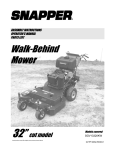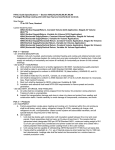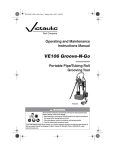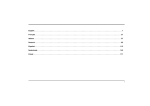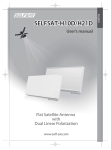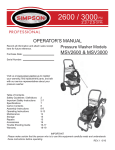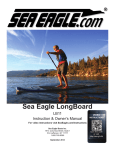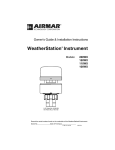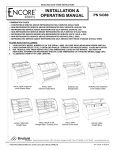Download Carrier WeatherExpert N7 Specifications
Transcript
HVAC Guide Specifications — Section 50N2,N3,N4,N5,N6,N7,N8,N9 Packaged Rooftop Cooling Unit with ComfortLink Controls and Optional Electric or Hydronic Heat Size Range: 75 to 150 Tons, Nominal Carrier Model Number: 50N2 (Vertical Supply/Return, Constant Volume [CV] Application, Staged Air Volume [SAV™]) 50N3 (Vertical Supply/Return, Variable Air Volume [VAV] Application) 50N4 (Horizontal Supply/Return, Constant Volume Application, Staged Air Volume) 50N5 (Horizontal Supply/Return, Variable Air Volume Application) 50N6 (Vertical Supply/Horizontal Return, Constant Volume Application, Staged Air Volume) 50N7(Vertical Supply/Horizontal Return, Variable Air Volume Application) 50N8 (Horizontal Supply/Vertical Return, Constant Volume Application, Staged Air Volume) 50N9 (Horizontal Supply/Vertical Return, Variable Air Volume Application) NOTE: Items throughout the specification which apply only to units with electric or hydronic heat are indicated by single brackets [i.e.,]. Part 1 — General 1.01 SYSTEM DESCRIPTION Outdoor, roof-curb mounted, electronically controlled cooling [and heating] unit utilizing hermetic scroll compressors with crankcase heaters for cooling duty [and utilizing electric resistance coils for heating duty]. Units shall supply air vertically or horizontally and return air vertically or horizontally as shown on the contract drawings. 1.02 QUALITY ASSURANCE A. Units shall be manufactured in a facility registered to ISO 9001 manufacturing quality standard. B. Unit shall be rated in accordance with AHRI Standard 340/360, latest edition. C. Unit shall be designed to conform to ANSI/ASHRAE 15 (latest edition), ASHRAE 62, and UL Standard 1995. D. Unit shall be listed by ETL and ETL, Canada, as a total package. E. Roof curb shall be designed to NRCA criteria per Guideline B-1986. F. Insulation and adhesive shall meet NFPA 90A requirements for flame spread and smoke generation. 1.03 DELIVERY, STORAGE, AND HANDLING A. All units shall be completely shrink-wrapped from the factory for protection during shipment. Tarping of units is unacceptable. B. Inspect for transportation damage and store in clean dry place and protect from weather and construction traffic. Handle carefully to avoid damage to components, enclosures, and finish. Part 2 — Products 2.01 EQUIPMENT A. Factory-assembled, single-piece heating and cooling unit. Contained within the unit enclosure shall be all factory wiring, piping, refrigerant charge (R-410A), operating oil charge, dual refrigerant circuits, microprocessor- based control system and associated hardware, and all special features required prior to field start-up. B. Unit Cabinet: 1. Unit shall be double-wall construction with insulation sealed between the inner and outer panels. Panel assemblies shall not carry an R-value of less than 8. The panels shall be galvanized steel (designated G60 per ASTM Standard A653 - minimum coating weight of 0.6 oz of zinc per square foot), bonderized and primer-coated on both sides and coated with a baked polyester thermosetting powder coating finish on the outer surface. 2. Unit casing shall be capable of withstanding ASTM Standard B117 500-hour salt spray test. 3. Casing shall be watertight at negative 7 in. wg of internal pressure when tested per the UL 1995 rain test requirements. Leakage rate shall be tested and documented on a routine basis on random production units. 4. Sides shall have person-size hinged access doors for easy access to the control box and other areas requiring servicing. Each door shall seal against a rubber gasket to prevent air and water leakage. Access doors shall be one piece, double-wall construction with insulation sealed between the inner and outer panels. Panel assemblies shall not carry an R-value of less than 8. Access doors shall be equipped with tiebacks. 5. Side panels shall be easily removable for access to unit and shall seal against a full perimeter automotive style gasket to ensure a tight seal. 6. Unit shall contain a double sloped drain pan, to prevent standing water from accumulating. Pan shall be fabricated of stainless steel. Unit shall contain a factoryinstalled nonferrous main condensate drain connection. 7. Top cover of airside section to be sloped to prevent standing water. 8. Units shall be equipped with lifting lugs to facilitate overhead rigging. Lifting lugs shall also be suitable as tie down points. C. Compressors: 1. Fully hermetic scroll type compressors with overload protection and short cycle protection with minimum on and off timers. 2. Factory rubber-in-shear mounted for vibration isolation. 3. Reverse rotation protection capability. 4. Crankcase heaters shall only be activated during compressor off mode. D. Coils: 1. Evaporator Coil: a. Intertwined circuiting constructed of aluminum fins mechanically bonded to seamless copper tubes. b. Full-face active type during full and part load conditions. c. Coils shall be leak tested at 150 psig and pressure tested at 650 psig. 2. Condenser Coils: a. Condenser coils shall be microchannel design. The coils shall have a series of flat tubes containing a series of multiple, parallel flow microchannels layered between the refrigerant manifolds. Microchannel coils shall consist of a two-pass arrangement. Coil construction shall consist of aluminum alloys for the fins, tubes and manifolds. b. Air-cooled condenser coils shall be leak tested at 150 psig and pressure tested at 650 psig. E. Fans: 1. Supply Fan: a. Unit shall have only one fan wheel, scroll, and motor. b. Fan scroll, wheel, shaft, bearings, drive components and motor shall be mounted on a formed steel assembly which shall be isolated from the unit outer casing with factory-installed 2-in. deflection spring isolators and vibration-absorbent fan discharge seal. c. Fan shall be double-width, double-inlet, centrifugal belt-driven airfoil type with single outlet discharge. d. Fan wheel shall be designed for continuous operation at the maximum rated fan speed and motor horsepower. e. Fan wheel and shaft shall be selected to operate at 25% below the first critical speed and shall be statically and dynamically balanced as an assembly. f. Fan shaft shall be solid steel, turned, ground and polished, and coated with rust preventative oil. g. Fan shaft bearings shall be self-aligning, pillow- block, regreasable ball or rollertype selected for a minimum average life of 200,000 hours at design operating conditions in accordance with ANSI B3.15. h. A single motor shall be mounted within the fan section casing on slide rails equipped with adjusting screws. Motor shall be mounted on a horizontal flat surface and shall not be supported by the fan or its structural members. Motor speed shall be controlled by a variable frequency drive. i. Fan drive shall be constant-speed fixed-pitch. All drives shall be factory-mounted, with belts aligned and tensioned. j. A high-static supply fan option shall be available. 2. Condenser Fans: a. Direct-driven propeller type. b. Discharge air vertically upward. c. Protected by PVC-coated steel wire safety guards. d. Statically and dynamically balanced. e. Three-phase, totally enclosed motors. F. Variable Frequency Drive: All supply fan (and power exhaust fan and/or return fan motors, if equipped) shall be equipped with variable frequency drive (VFD) inverter. The VFD shall be provided with a metal enclosure and shall be factory- mounted, wired, and tested. The variable speed drive shall include the following features: 1. Full digital control with direct control from the unit ComfortLink controls. 2. Insulated gate bi-polar transistors (IGBT) used to produce the output pulse width modulated (PWM) waveform, allowing for quiet motor operation. 3. Inverters capable of operation at a frequency of 8 kHz so no acoustic noise shall be produced by the motor. 4. VFDs shall include EMI/RFI (electromagnetic / radio frequency interference) filters. 5. Digital display keypad module, mounted on the VFD enclosure. 6. Local/Remote and Manual/Auto function keys on the keypad. 7. UL-listed electronic overload protection. 8. Critical frequency avoidance. 9. Self diagnostics. 10. On-board storage of unit manufacturer's customer user settings, retrievable from the keypad. 11. RS485 communications capability (accessory card source required). 12. Internal thermal overload protection. 13. 5% swinging (non-linear) chokes for harmonic reduction and improved power factor. 14. All printed circuit boards shall be conformal coated. G. Outdoor-Air Hood Assembly: Factory-installed motorized outdoor-air damper shall allow intake of up to 100% nominal airflow (on units not equipped with optional economizer). H. [Electric Heating Section:] Electric resistance heaters shall be factory installed, open wire nichrome element type, insulated with ceramic bushings, and shall include operating and safety controls. I. [Hydronic Heating Section:] Hydronic heating option shall consist of factory-installed plate fin-tube coil assembly, installed in the extended length section. Coil assembly shall be supplied with die-formed casing and tube sheets of mill galvanized steel. Tubes shall be minimum 1/2-in. OD copper tubes mechanically expanded into aluminum plate fin coils with belled collars. Headers shall be constructed of steel with steel MPT connections. Headers shall have drain and vent connections. Coils shall be suitable for a design working pressure of 300 psig at 200 F. Coils shall be tested at 450 psig air pressure. J. [Steam Heating Section:] Steam heating option shall consist of factory-installed plate fin-tube coil assembly, installed in the extended length section. The steam coil shall be non-freeze type heating coils: 1. Headers shall be steel with MPT connections. 2. Inner steam distributing tubes shall be 5/8-in. OD, 0.020 in. wall thickness, located within 1 in. OD, 0.035 in. wall outer condensing tubes. Working pressure shall be 175 psig at 400 F. K. Refrigerant Components: Unit shall be equipped with dual refrigerant circuits, each containing: 1. Filter drier. 2. Moisture indicating sight glass. 3. Two electronic expansion valves. 4. Fusible plug. L. Filter Section: 1. Mixed air filter section shall consist of 2-in. thick, MERV 5 disposable fiberglass filters of commercially available sizes. Optional pleated, bag and cartridge filters shall be available. (See special features section.) 2. Optional final filters with pre-filters shall be available. (See special features section.) M. Controls, Safeties, and Diagnostics: 1. Controls: a. Control shall be accomplished through the use of a factory-installed, microprocessor-based control system and associated electronic and electrical hardware. Control system shall determine control sequences through monitoring the following operational variables: 1) Day and Time. 2) Schedule (Unoccupied/Occupied). 3) Set points (Unoccupied/Occupied, Economizer, Duct Pressure, others). 4) Space temperature. 5) Outdoor-air temperature. 6) Unit supply-air temperature. 7) Unit return-air temperature. 8) Supply-air fan status. 9) Economizer position. 10) Compressor suction and discharge pressure. 11) Navigator display. 12) Accessory and/or field-supplied sensors, function switches and/or signals. b. Controls shall be capable of performing the following functions: 1) Capacity control based on supply-air temperature and compensated by rate of change of return-air temperature (VAV) or room temperature (CV). Capacity control shall be accomplished through the use of compressor staging or optional variable output compressors. 2) Perform a quick test to check the status of all input and output signals to the control system using the Navigator™ display. 3) Control of integrated economizer operation, based on unit supply-air temperature. 4) Supply fan volume control shall control output from a variable frequency drive to maintain duct static pressure at user-configured set point (VAV). Static pressure reset in conjunction with Carrier communicating terminals to reduce supply fan power requirements. Control system calculates the amount of supply static pressure reduction necessary to cause the most open damper in the system to open more than the minimum value (60%) but not more than the maximum value (90% or negligible static pressure drop). 5) Heating control shall provide space temperature control for unoccupied period heating, morning warm-up sequence and occupied period heating (when configured). Leaving-air temperature control shall be provided when unit is equipped with SCR controlled electric, hydronic or steam heat options. 6) Adaptive optimal start shall determine the time unit will commence cooling (or heating or heating for morning warmup) during the unoccupied mode to ensure occupied space reaches the set point in time for occupied mode. 7) Adaptive optimal stop shall turn off the compressors a preset amount of time before the end of the occupied mode to conserve energy (CV only). 8) Alerts and Alarms: Control shall continuously monitor all sensor inputs and control outputs to ensure safe and proper system operation. Alerts shall be generated whenever sensor conditions have gone outside criteria for acceptability. Alarms shall be initiated when unit control detects that a sensor input value is outside its valid range (indicating a defective device or connection that prevents full unit operation) or that an output has not functioned as expected or that a safety device has tripped. Current alarms shall be maintained in STATUS function; up to 9 (current or reset) shall be stored in HISTORY function for recall. 9) Timed override function shall permit a system in unoccupied mode to be returned to occupied mode for a user-configured period of 1, 2, 3 or 4 hours by pressing the override button on the front of the space temperature sensor. 10) Nighttime Free Cooling (NTFC) shall start the supply fan and open the economizer on cool nights to pre-cool the building structure mass using only outdoor air. Function shall be restricted to operation above a user-configured low lockout temperature set point. 11) Modulating power exhaust control shall utilize a VFD to modulate capacity of exhaust fan system. Capacity of exhaust air shall be modulated in response to building static pressure at user-configured set point. Power exhaust fan operation shall be interlocked with supply fan operation. 12) Return fan control (on optional return fan equipped units only) shall measure supply fan cfm and shall utilize a VFD to modulate the return fan to maintain constant cfm differential between supply and return fan. Return fan operation shall be interlocked with supply fan operation. Capacity of exhaust air shall modulated in response to building static pressure at user-configured set point. 13) Smoke control functions: Control shall initiate any of four separate smoke control functions in response to closure of field switches. Functions shall include: Pressurization, Evacuation, Smoke Purge and Fire Shutdown. Should two or more switches be closed simultaneously, Fire Shutdown shall be initiated. 14) Support demand controlled ventilation through a reset of the economizer's minimum position. This reset based on differential CO2 ppm (outdoor and indoor) can be chosen as linear or as fast or slow-acting exponential curves. 15) Indoor air quality (IAQ) mode shall admit fresh outdoor air into the space whenever space air quality sensors detect unsuitable space conditions, by overriding economizer minimum damper position. IAQ shall be permitted only during occupied periods, unless configured to be allowed during unoccupied periods also. 16) Provide control for reheat via auxiliary heating coil during ventilation. 17) IAQ pre-occupancy purge function shall provide complete exchange of indoor air with fresh air during unoccupied periods, when outdoor conditions permit. Function shall energize supply fan and open economizer two hours before next occupied period; duration of purge shall be user-configured (5 to 60 minutes). 18) Outdoor Air Control (OAC) function shall maintain a minimum quantity of outdoor airflow into an occupied space. OAC mode shall be available only during an occupied period. Outdoor airflow shall be monitored by an airflow station and transducer. Economizer maximum damper opening position during OAC mode shall be user-configured. 19) Dehumidification and Reheat: Dehumidification function shall override comfort condition set points to deliver cooler air into the space and satisfy a user-configured humidity set point at the space or return air humidity sensor. Reheat function shall energize an auxiliary heating device should dehumidification operation result in cooling of the space down to the occupied heating set point. 20) Supply Air Temperature Set Point Reset: Control shall automatically reset the unit supply air temperature set point on VAV models from either space temperature or return-air temperature, at user-configured rate and limit. Control shall also reset supply air temperature set point via external 2 to 10 vdc signal representing 0° to 20 F range of reset. Control shall respond to higher of either reset if both are active. 21) Space Temperature Offset function shall permit occupants to adjust space temperature set point by ±5° F using T-56 space sensor (equipped with sliding scale adjuster). 22) Lead-lag function shall distribute starts between the two refrigeration circuits in an effort to equalize the running time on the two circuits. 23) Condenser-fan cycling control shall maintain correct head pressure down to 32 F. 24) Refrigeration system pressures shall be monitored via pressure transducers. Alarms for low pressure, high pressure will be permitted. 25) Timed Discrete Output function shall control an external function or device via user-configured activity schedule. This schedule shall be separate and different from the unit's occupied/unoccupied time schedule. 26) Hydronic heating coil control shall modulate a control valve in a steam or hydronic heat system to maintain space temperature at user-configured set points. Control valve actuator shall communicate via LEN (Local Equipment Network) protocol. 27) Humidifier control shall provide control for either LEN communicating control valve or discrete-type output, to maintain space humidity conditions at userconfigured set points. 28) Two-step demand limit control (when used in conjunction with CEM [controls expansion module]). 29) Display in Metric units: Display may be configured to display data in Metric or English (Imperial) units of measure. 2. Safeties: Unit components shall be equipped with the following protections: a. Compressors: 1) Overcurrent using calibrated circuit breakers (shuts down individual compressor). 2) Crankcase heaters. 3) High-pressure switch (shuts down individual circuit, automatic reset type). 4) Low-pressure monitoring (shuts down individual circuit, automatic reset type). b. Check filter switch. c. Belt-Drive Fan Motors: Overcurrent protection manual reset circuit breakers. d. [Electric Heating Section]: 1) Automatic reset high-temperature limit switches. 2) Manual reset high temperature limit switch. 3) Primary and backup contactors. 4) Branch circuit protection. 5) Airflow proving switch. 3. Diagnostics: a. The display shall be capable of indicating a safety lockout condition (alarm). b. The display shall also be capable of indicating an alert condition which does not lock out the unit, but informs the system monitor of a condition which could be detrimental to either the unit or the comfort of the occupants if allowed to continue. c. N. O. P. Q. Test mode must also be capable of displaying outputs of microprocessorcontroller and to verify operation of every thermistor, actuator motor, fan, and compressor before unit is started. 4. Navigator™ Display Interface: The Navigator display module shall be a portable hand-held display module with a minimum of 4 lines and 20 characters per line, of clear English language. Display menus shall provide clear language descriptions of all menu items, operating modes, configuration points and alarm diagnostics. Reference to factory codes shall not be accepted. An industrial grade coiled extension cord shall allow the display module to be moved around the chiller. Magnets shall hold the display module to any sheet metal panel to allow hands-free operation. Display module shall have NEMA 4x housing suitable for use in outdoor environments. Display shall have back light and contrast adjustment for easy viewing in bright sunlight or night conditions. The display module shall have raised surface buttons with positive tactile response. Operating Characteristics: 1. Unit shall be capable of starting and running at 115 F (125 F for high-efficiency models) ambient outdoor temperature per maximum load criteria of AHRI Standard 340/360, latest edition. 2. Unit shall be capable of mechanical cooling operation down to 32 F ambient outdoor temperature (–20 F with low ambient accessory). 3. Provides multi-stage cooling capability. 4. [Provides 2 stages of electric heating capability.] Motors: 1. Compressor motors shall be cooled by suction gas passing over motor windings. 2. Condenser-fan motors shall be 3-phase, totally enclosed type with permanently lubricated ball bearings and internal over-temperature protection. 3. Supply and exhaust fan motors shall be of the 3-phase, NEMA rated, open drip-proof (ODP), ball bearing type, with efficiencies per EISA of 2007 (U.S.A.) requirements. Electrical Requirements: All unit power wiring shall enter unit cabinet at a single location. Special Features: 1. Digital Compressor: A digital compressor shall be available on the lead circuit for constant volume and variable air volume configurations. The ComfortLink control system shall be capable of unloading this compressor in an infinite number of steps from 100% of unit capacity down to 50% of unit capacity. 2. Humidi-MiZer® Adaptive Dehumidification: The Humidi-MiZer dehumidification system shall be factory installed and shall provide greater dehumidification of the occupied space by using two modes of dehumidification instead of the normal design cooling mode of the unit: a. Subcooling mode shall further sub-cool the hot liquid refrigerant leaving the condenser coil when both temperature and humidity in the space are not satisfied. b. Hot gas reheat mode shall mix a portion of the hot gas from the discharge of the compressor with the hot liquid refrigerant leaving the condenser coil to create a two-phase heat transfer in the system, resulting in a neutral leaving-air temperature. c. The system shall be equipped with modulating control valves to provide precise leaving-air temperature control. On-off, cycling type control shall not be acceptable. 3. Condenser Coil Protective Coating - E-Coated Microchannel Coil: E-coated aluminum microchannel coils shall have a flexible epoxy polymer coating uniformly applied to all coil external surface areas without material bridging between fins or louvers. Coating process shall ensure complete coil encapsulation, including all exposed fin edges. E-coat thickness of 0.8 to 1.2 mil with top coat having a uniform dry thickness from 1.0 to 2.0 mil on all external coil surface areas, including 4. 5. 6. 7. 8. 9. 10. 11. 12. fin edges, shall be provided. E-coated coils shall have superior hardness characteristics of 2H per ASTM D3363-00 and cross-hatch adhesion of 4B-5B per ASTM D3359-02. E-coated coils shall have superior impact resistance with no cracking, chipping, or peeling per NSF/ANSI 51-2002 Method 10.2. Condenser Coil Louvered Guard: Louvered panels complete with support retainers and fasteners shall be provided for protection of condenser coils. Condenser Coil Grille Guard: Welded wire grille complete with support retainers and fasteners shall be provided for protection of condenser coils. Low Outdoor Sound: Low sound fans for outdoor sound reduction shall be available as a factory-installed option for all units (except 90-ton high-efficiency, 105- ton, 120-ton high-efficiency, 130-ton high-efficiency and 150-ton units). Low Ambient Control: a. Control shall regulate fan motor speed in response to the saturated condensing temperature of the unit. The control shall be capable of operating with outdoor temperatures at –20 F. b. Motormaster® low ambient control shall be available as a factory-installed option or fieldinstalled accessory for all units. Service Valves: Shall be equipped with ball type service valves in the suction, discharge and liquid line for each circuit. Replaceable Core Filter Drier: Shall be equipped with a replaceable core filter drier with isolation valves in each liquid line. Hot Gas Bypass: Unit shall be factory equipped with hot gas bypass valve, and tubing to maintain capacity control at minimal cooling loads. Evaporator Coil Options: a. Copper-fin coils shall be constructed of copper fins mechanically bonded to copper tubes and copper tube sheets. Galvanized steel tube sheets shall not be acceptable. A polymer strip shall prevent coil assembly from contacting the sheet metal coil pan to minimize potential for galvanic corrosion between coil and pan. All copper construction shall provide protection in moderate coastal environments. b. E-coated aluminum-fin coils shall have a flexible epoxy polymer coating uniformly applied to all coil surface areas without material bridging between fins. Coating process shall ensure complete coil encapsulation. Color shall be high gloss black with gloss - 60 deg of 65 to 90% per ASTM D523-89. Uniform dry film thickness from 0.8 to 1.2 mil on all surface areas including fin edges. Superior hardness characteristics of 2H per ASTM D3363-92A and crosshatch adhesion of 4B-5B per ASTM D3359-93. Impact resistance shall be up to 160 in./lb (ASTM D279493). Humidity and water immersion resistance shall be up to minimum 1000 and 250 hours respectively (ASTM D2247-92 and ASTM D870-92). Corrosion durability shall be confirmed through testing to be no less than 1000 hours salt spray per ASTM B117-90. Coil construction shall be aluminum fins mechanically bonded to copper tubes. Motorized Outdoor Air Damper: a. Package consisting of dampers, actuator, and linkages in conjunction with control system to provide outdoor air. b. Dampers shall be an ultra low-leakage type with blade and edge seals. Dampers shall exhibit a maximum leakage rate of 4 cfm per square foot of area at 1 in. wg pressure differential when tested in accordance with AMCA Standard 500. c. Dampers shall function as intended after 100,000 cycles when tested in accordance with Section 8, UL standard 555S. 13. Ultra Low Leak Economizer: Dry bulb, differential dry bulb temperature, enthalpy, or optional differential enthalpy controlled integrated type consisting of dampers, actuator, and linkages in conjunction with control system to provide primary cooling using outdoor air, enthalpy permitting, supplemented with mechanical cooling when necessary. a. Economizer shall meet the requirements of the California Energy commission airside economizer acceptance test. b. Dampers shall be an ultra low-leakage type with blade and edge seals. Dampers shall exhibit a maximum leakage rate of 4 cfm per square foot of area at 1 in. wg pressure differential when tested in accordance with AMCA Standard 500. c. Dampers shall function as intended after 100,000 cycles when tested in accordance with Section 8, UL standard 555S. d. Actuator shall have a spring-return feature which shuts dampers upon a power interruption or unit shutdown. Actuators are capable of internal diagnostics. e. Equipped with a solid-state humidity sensor that is capable of sensing outdoor-air heat content (temperature and humidity) and controlling economizer cut-in point at most economical level. The user can also configure dew point limiting. 14. Modulating Power Exhaust with VFD: Package shall include a double-width, double-inlet centrifugal belt drive, forwardcurved power exhaust fan with variable frequency drive control to maintain a field adjustable interior space pressure set point. a. Fan bearings shall be of the pillow block type with an average design life of 200,000 hours. b. Fans shall be statically and dynamically balanced. c. Installation: 1) Site installation shall require supply and installation of building pressure (BP) sensing pick-up and tube to connect to BP transducer in unit. 2) All other wiring and pressure tubing shall be factory-supplied and factoryinstalled. d. Bypass for the VFD shall be available as a factory-installed option. e. A high-static power exhaust option shall be available. 15. Return Fan/Building Pressure Control: a. Functions provided shall be: 1) Airflow control for return duct path (dedicated to overcoming flow losses in return duct system). 2) Modulate return airflow rate to track supply fan airflow rate and maintain a user set delta cfm between the supply and return airflow. 3) Maintain building pressure by sensing building pressure and modulating fan motor speed. b. Option shall consist of following hardware: 1) Plenum fan assembly, with welded steel airfoil blade fan. 2) Spring isolation. 3) Belt-drive fan system, fixed pitch for maximum belt life and reliability. 4) Variable frequency drive (VFD) for return fan modulation control. 5) Supply air cfm and return air cfm sensors to measure supply and return airflow. 6) Exhaust damper with outlet hood. 7) Building pressure transducer. c. Installation: 1) Site installation shall require supply and installation of building pressure (BP) sensing pick-up and tube to connect to BP transducer in unit. 2) All other wiring and pressure tubing shall be factory-supplied and factory installed. d. A high-static return fan option shall be available. 16. Extended Lube Lines: 17. 18. 19. 20. 21. 22. Unit shall be equipped with extended lube lines to facilitate lubrication of fan bearings from one side of the unit. Belt Guard: Unit shall be equipped with belt guard on all belt driven fans. The guard shall completely enclose the drive system and be removable for service. Mixed Air Filters: Unit shall be factory equipped with: a. 4 in. MERV 8 pleated filters having the following characteristics: Efficiency of no less than 30% based on testing per ASHRAE Standard 52 and a minimum average arrestance of 95%. b. 4 in. MERV 14 pleated filters having the following characteristics: Efficiency of no less than 90% based on testing per ASHRAE Standard 52 and a minimum average arrestance of >98%. c. 12 in. MERV 14 bag filters having the following characteristics: Efficiency of no less than 90% based on testing per ASHRAE Standard 52 and a minimum average arrestance of >98%. This option shall be available with 2 in. or 4 in. prefilters. d. 19 in. MERV 15 bag filters having the following characteristics: Efficiency of > 95% based on testing per ASHRAE Standard 52. This option shall be available with 2 in. or 4 in. pre-filters. e. 12 in. MERV 14 cartridge filters having the following characteristics: Efficiency of no less than 90% based on testing per ASHRAE Standard 52 and a minimum average arrestance of >98%. This option shall be available with 2 in. or 4 in. prefilters. f. Field use filter section. The section shall be 4 ft in length and include 2 in. MERV 7 pleated filters. Final Air Filters: Unit shall be factory equipped with: a. 12 in. MERV 14 cartridge filters having the following characteristics: Efficiency of no less than 90% based on testing per ASHRAE Standard 52 and a minimum average arrestance of >98%. This option shall be available with 2 in. or 4 in. prefilters. b. 19 in. MERV 15 bag filters having the following characteristics: Efficiency of > 95% based on testing per ASHRAE Standard 52. This option shall be available with 2 in. or 4 in. pre-filters. c. 12 in. MERV 17 HEPA filter. This option shall be available with 2 in. or 4 in. prefilters. Totally Enclosed Fan Cooled (TEFC) Motors: Unit shall be equipped with premium-efficiency TEFC supply fan motor. Power exhaust or return fan motor (if equipped) shall also be TEFC type. VFD Bypass: a. VFD bypass shall be UL Listed by the drive manufacturer as a complete assembly and carry a UL 508 label. b. The VFD bypass shall be a complete factory-wired and tested bypass system consisting of an output contactor and bypass contactor. Overload protection and shall be provided in both drive and bypass modes. c. The following operators shall be provided: 1) Drive mode selector 2) Bypass mode selector d. When selector set to bypass, normally open contacts shall close to provide the bypass status to the unit's control system. While in bypass mode, the control system shall operate the supply fan using relay contacts to control the bypass contactor. e. Motor overload protection shall be included. Supply Fan Static Pressure Control (VAV units): 23. 24. 25. 26. 27. 28. 29. 30. Variable air volume units shall be equipped with a supply fan VFD. The VFD shall control motor speed to maintain set point static pressure control at the supply duct sensor tube location. The supply fan drive shall be field-adjustable to maintain supply duct static pressure set point from 0.0-in. wg to 5-in. wg, adjusted via scrolling marquee display or Navigator™ display. A pressure transducer shall be factorymounted and wired. (Control tubing from sensor tube location to transducer shall be field-supplied and installed.) Transducer shall provide a 4 to 20 mA signal to the unit control module; unit control module shall provide a 4 to 20 mA signal to the VFD indicating desired VFD output level. Staged Air Volume (SAV) units: Staged air volume units shall be equipped with a supply fan VFD. The VFD shall control motor speed to user-configurable speeds. High speed shall be a percentage of 60 Hz, and shall be user configurable. The range of adjustment for high speed shall be between 50 and 100% of 60 Hz. Low speed shall be a percentage of 60 Hz, and shall be user configurable. The range of adjustment for low speed shall be between 33 and 67% of 60 Hz. The control shall allow user-configurable fan speeds for cooling and heating modes. [SCR Controlled Electric Heat:] a. SCR electric heat option shall monitor unit supply-air temperature and control the unit heater section to provide the following sequences: 1) Demand heating control, with modulation to maintain user-configured heating supply air temperature set point. 2) Full output heating on heating control command. 3) Tempering heat control, based on user-configured ventilation supply air temperature set point, to eliminate cold draft conditions with low mixed-air temperatures. b. SCR heat control option shall consist of: 1) SCR controller capable of ensuring the proper heating rates. 2) Supply air temperature thermistors with duct-mounting base. 3) Limit switch temperature thermistors. c. Field installation shall be limited to installing three supply air temperature thermistors in the supply duct. All other hardware and wiring shall be factorycompleted. Discharge Plenum: Discharge plenum design shall contain added length module for bottom supply air discharge, as shown in contract drawings. Discharge plenum design shall provide horizontal discharge arrangement supply fan which shall discharge into insulated plenum. Interior cabinet surfaces within discharge plenum section shall be lined with sheet metal on all surfaces, insulated on the side opposite the airstream. Electric heat is not available with discharge plenum models. Blank Section: A 4 ft or 8 ft blank section shall be available for field installation of field-supplied devices. Extended Chassis: Extended chassis designs shall contain an added length module, after the evaporator section, as shown in the contract drawings. Module shall contain tracks to accept field-supplied/installed auxiliary heating coil. Agion® Interior: Interior panels shall be pre-coated with a silver zeolite antimicrobial material registered by the US EPA for use in HVAC applications. Split Unit: The unit shall be available for shipment in two sections dependent upon the options selected. UV-C Germicidal Lamps: Emitters and fixtures for UV-C lamps shall be designed for use inside an HVAC system and shall be covered by a 1-year warranty. Individual lamp output shall be measured in an ASME nozzled test apparatus using a 45 F airstream moving at not less than 400 fpm. Lamp output at 253.7 nm shall not be less than 10 μW/cm2 per inch of arc length measured at a distance of one meter. a. Power supplies for UV-C lamps shall be a high-efficiency electronic type which are matched to the emitters and are capable of producing the specified output intensity with an input power no more than 80 watts. b. Fixtures for UV-C lamps shall be factory-installed and wired to a SPDT disconnect switch and door interlock switches in each door. Fixtures are wired for 120 v/single phase requiring a minimum circuit ampacity of 15 amps. Field power connections are made at the switch box mounted on the exterior of the unit. Lamps shall ship separately for field installation to minimize the chance for bulb damage. c. Emitters and fixtures shall be installed in sufficient quantity and arranged so as to provide an equal distribution of UV-C energy on the coil and drain pan. d. The minimum UV-C energy striking the leading edge of the coil pan shall be not less than 820 μW/cm2 at the closest point and through placement, not less than 60% of that value at the farthest point. Equal amounts are to strike the drain pan, either directly or indirectly through reflection. e. Emitters and fixtures shall be installed such that UV-C energy strikes all surfaces of the coil, drain pan, and the available line of sight airstream. 31. Marine Lamps: Marine Lights shall be: a. Cast, non-ferrous metal, weatherproof, fixture. b. Cast, non-ferrous metal, weatherproof, electrical junction box. c. Gasketed, heat and shock resistant glass globe protects against moisture and debris. d. Cast, non-ferrous metal lamp guard to protect glass globe. e. UL listed. f. 100 watt type 'A' lamp maximum capacity. g. Each fixture is equipped with a 75 watt, 130 volt, long life, vibration resistant, lamp (8000+ hour typical lamp life), factory installed. h. Metallic, single gang, electrical junction box, UL listed. i. Factory-supplied and wired, SPST, UL listed toggle switch. j. Each fixture is factory wired to an externally mounted switch box. (Field power connections are made to the switch box mounted externally on the unit.) k. All factory wiring penetrating through the panel is protected in 'RIGID' type metal conduit. 32. Non-Fused Disconnect: A non-fused electrical disconnect for main unit power shall be factory installed. The disconnect shall be an interlocking through-the-door type. 33. Fused Disconnect: A fused electrical disconnect for main unit power shall be factory installed. The disconnect shall be an interlocking through-the-door type. 34. 115-Volt Convenience Outlet: A duplex GFCI (ground fault circuit interrupt) receptacle shall be factory mounted in a weatherproof enclosure and wired for a 10- amp load. It will remain powered when all unit circuit breakers have been turned off. The outlet will be deenergized by the unit disconnect. 35. Phase/Voltage Monitor: Package shall include a device capable of detecting under/over voltage, phase loss or phase shift. The device shall take action to protect the unit if an abnormal condition is detected. 36. Short Circuit Current Rating (SCCR): An optional SCCR of 65 kA shall be provided for 460-volt units. An optional of 25 kA shall be provided for 575-volt units. 37. Navigator™ Display Module Accessory: 38. 39. 40. 41. 42. 43. 44. 45. The Navigator display module shall be a portable hand-held display module with a minimum of 4 lines and 20 characters per line, of clear English language. Display menus shall provide clear language descriptions of all menu items, operating modes, configuration points and alarm diagnostics. Reference to factory codes shall not be accepted. An industrial grade coiled extension cord shall allow the display module to be moved around the rooftop. Magnets shall hold the display module to any sheet metal panel to allow hands-free operation. Display module shall have NEMA 4x housing suitable for use in outdoor environments. Display shall have back light and contrast adjustment for easy viewing in bright sunlight or night conditions. The display module shall have raised surface buttons with positive tactile response. Controls Expansion Module (CEM): Factory-installed package shall include all hardware for additional control of base unit operation and product integrated controls features. The functions supported are: a. Building pressurization, evacuation, and smoke purge control. b. Supply air reset from external 4 to 20 mA signal. c. Two-step demand limit inputs (when used with the CCN network). d. Indoor air quality (IAQ) switch monitoring. e. Outdoor airflow monitoring. f. Outdoor humidity monitoring. g. Space humidity monitoring (required for dehumidification control, reheat and humidifier control). h. Return air humidity monitoring. i. Demand limiting from an external 4 to 20 mA signal. j. Static pressure reset from an external 4 to 20 mA signal. k. Pre and post filter switch monitoring Relative Humidity Sensors: Package shall contain either duct-mounted or wall-mounted sensors to measure the relative humidity of the air within the occupied space (specify location) or return duct and/or outside air. NOTE: For relative humidity sensor monitoring, the CEM must also be ordered. Indoor Air Quality (CO2) Sensor: a. Shall have the ability to provide demand ventilation indoor-air quality (IAQ) control through the economizer with an indoor air quality sensor. b. The IAQ sensor shall be available in duct mount, wall mount, and wall mount with LED display of CO2 in parts per million. The set point shall have adjustment capability. Return Air Smoke Detector: The smoke detector shall send input to the controller to shut down the unit in case smoke is detected. Airflow Sensor: Airflow sensor package shall contain a airflow station with airflow sensor, a transducer and all hardware required to measure the quantity of air. Optional economizer and CEM are required with this option. Sensor package shall be available for outdoor air, supply air, and exhaust airflows. Differential Enthalpy Switch or Sensors (when equipped with both return air and outdoor air humidity sensors): a. For use with economizer only. b. Capable of comparing heat content (temperature and humidity) of outdoor and return air and controlling economizer cut-in point at the most economical level. BACnet Communication Option: Shall provide factory-installed communication capability with a BACnet MS/TP network. Allows integration with i-Vu® Open Control System or a BACnet Building Automation System. MODBUS Protocol Translator: A controller-based accessory module shall provide CCN access to MODBUS Remote Terminal Unit (RTU) protocol conversion. 46. LonWorks Protocol Translator: A controller-based accessory module shall provide CCN access to LON FT-10A ANSI/EIA-709.1 protocol conversion. 47. Space Temperature Sensor (T-56): The T-56 space temperature sensor (for CV applications) shall monitor space temperature. Device shall be suited for wall mounting in the occupied space. The T56 sensor shall incorporate a front-panel located slider switch to effect a remote change in set point of ±5° F. The T-56 sensor shall also include a button used to initiate Unoccupied Override function. 48. Space Temperature Sensor (T-56) with CO2 Sensor: This device shall incorporate interior space temperature sensing and interior space CO2 level monitoring functions. Space temperature sensor shall sense the actual temperature in the conditioned space via 10,000-ohm thermistor. Temperature set point adjustment potentiometer via slide scale shall provide ±5° F adjustment. CO2 sensor shall provide CO2 measurement range of 0 to 2000 ppm. IAQ signal to unit base board terminals shall be 4 to 20 mA. Sensor shall be equipped with an override button for timed override. Sensor must be powered by a separate field-supplied 24-v transformer. 49. Roof Curb: Designed to comply with criteria established by NRCA Guideline B-1986. Formed 14gage galvanized steel with wood nailer strip as perimeter curb supporting the airhandling portion of unit, and rail for supporting the condenser portion of the unit. 50. Roof Curb Condenser Section: Formed 14-gage galvanized steel with wood nailer strip for supporting condenser section of the unit to complete a full perimeter curb under entire unit. 51. Low Compressor Sound Blanket: Low compressor sound blanket accessory shall be available for field installation.














